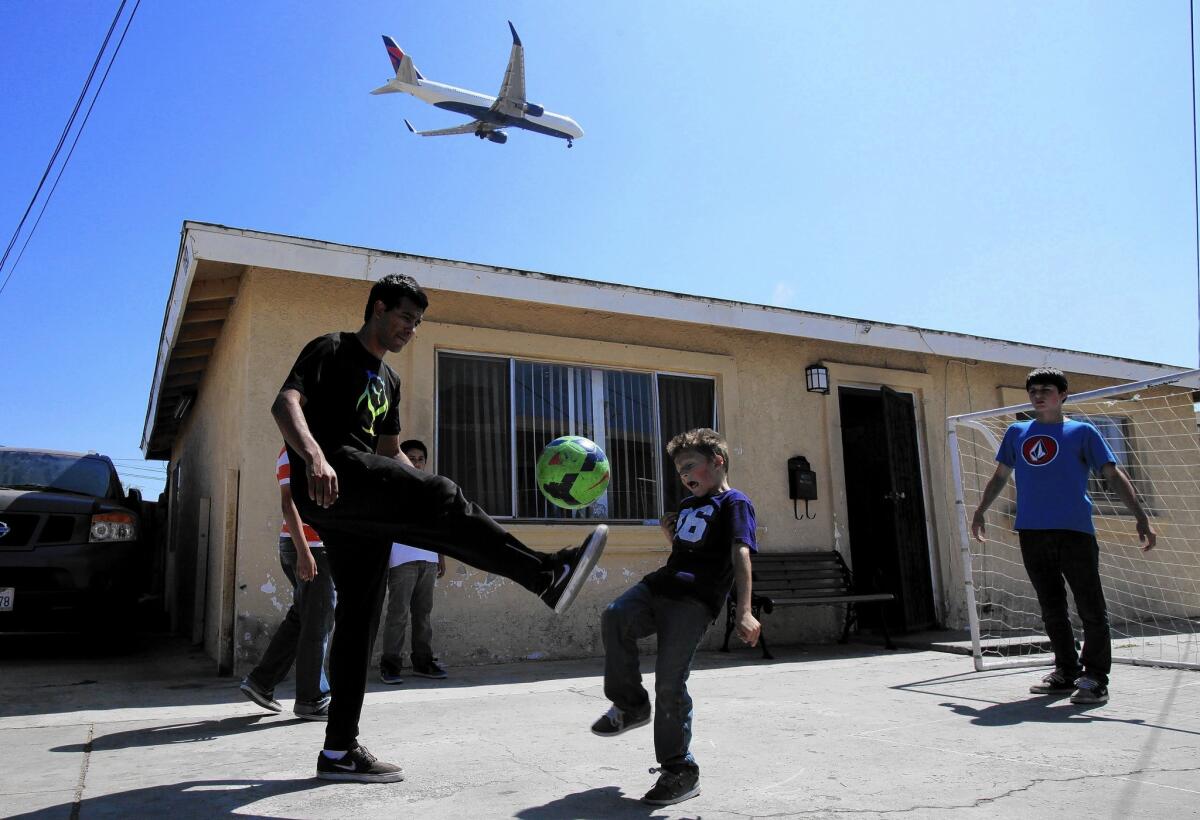Planes’ exhaust could be harming communities up to 10 miles from LAX

- Share via
High levels of potentially harmful exhaust particles from jets using Los Angeles International Airport have been detected in a broad swath of densely populated communities up to 10 miles east of the runways, a new air quality study reported Thursday.
The research, believed to be the most comprehensive of its type, found that takeoffs and landings at LAX are a major source of ultrafine particles. They are being emitted over a larger area than previously thought, the study states, and in amounts about equal in magnitude to those from a large portion of the county’s freeways.
It further concludes that areas affected by aircraft exhaust at major airports in the U.S. and other parts of the world might have been seriously underestimated.
Building on earlier air quality studies, environmental and preventive medicine experts from USC and the University of Washington found concentrations of the wind-driven particles over a 23-square-mile area that includes cities and unincorporated areas along LAX’s flight paths, including Lennox, El Segundo, Inglewood and parts of Los Angeles.
The findings raise health concerns, researchers say, because the minute particles, which result from the condensation of hot exhaust vapor from cars, diesel trucks and aircraft, have the potential to aggravate heart and lung conditions, including asthma and the development of blocked arteries.
Less than one-thousandth the width of a human hair, they can go deep in the lungs, make their way into the bloodstream and spread to the brain, heart and other critical organs. While emissions of slightly larger exhaust particles are regulated, ultrafines are not.
“This is a very novel and alarming set of results,” said Ralph Delfino, a professor of epidemiology at UC Irvine who studies the health effects of air pollution and reviewed the study. “It’s all very, very surprising.”
Officials at the region’s air quality agency, the South Coast Air Quality Management District, said there is little they can do to reduce pollution from airports because they do not have the power to regulate aircraft emissions. They have suggested to other agencies, including the U.S. Environmental Protection Agency, that the nation should have a standard for ultrafine particles, as exists in Europe.
Researchers found some of the highest particle levels — 6 to 8 times above normal — within a few miles of the nation’s third-busiest airport. Some readings almost 10 times above normal were encountered in pockets closest to LAX. Levels up to twice the norm were detected at 10 miles out.
The affected area starts at the ends of the airport’s four runways and fans out across an urban-scape that contains low-income neighborhoods and sections also affected by noisy overflights.
The extent of the pollution is so large that it challenges previous assumptions that roadways are the most significant pollution threat to urban residents. In some communities, the study states, many people may be exposed to a greater amount of particle pollution living downwind from LAX than from residing near highways.
Researchers calculated that it would take between 174 and 491 miles of freeway traffic — or about 20% to 50% of the highways in Los Angeles County — to generate levels of pollution equivalent to those detected east of LAX.
“We rightly spend a lot of time worrying about schools and homes that are close to freeways, but here’s a huge source of ultrafine particles that we’ve apparently missed,” said Scott Fruin, a professor of preventive medicine at USC’s Keck School of Medicine who led the research.
The bulk of the study was conducted last year, when scientists spent weeks taking measurements from two vehicles filled with air quality monitoring devices. They drove north-south routes through residential streets and major thoroughfares, measuring pollution concentrations at increasing distances from the airport.
“We kept looking for the end of the impact and never really found it,” Fruin said. “We never reached a point far enough downwind that we didn’t measure” particles from LAX.
Residents of cities along the heavily traveled flight paths said the new study validates their long-standing complaints that LAX is a significant source of air pollution in their neighborhoods, where jet exhaust has covered their homes, cars and outdoor furniture with soot.
“This confirms what we have been saying all along,” said Diane Sambrano, a community activist who lives in Inglewood. “We’ve been called every name in the book for complaining. Yet we know what we are talking about.”
The study’s conclusions are consistent with earlier work that found elevated levels of ultrafine particles near LAX and Santa Monica Airport, a general aviation facility. The latest research, however, recorded significant concentrations of the pollutant at much greater distances from LAX.
In addition to ultrafine particles, researchers detected similarly high levels of other emissions, including smog-forming gases called nitrogen oxides and black carbon, a major component of soot found in engine exhaust.
“My biggest concern is for people in and near the airport,” said Denny Schneider of Westchester, president of the Alliance for a Regional Solution to Airport Congestion. “We have identified something that is not just a boogeyman, but a real issue. Now we have to find out how to stop it.”
Philip Fine, the air district’s assistant deputy executive officer, called the study’s findings “novel and compelling” and said they make a strong case for addressing the emissions.
“It will perhaps push toward further controls, hopefully, and further regulation,” he said.
More to Read
Sign up for Essential California
The most important California stories and recommendations in your inbox every morning.
You may occasionally receive promotional content from the Los Angeles Times.












